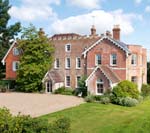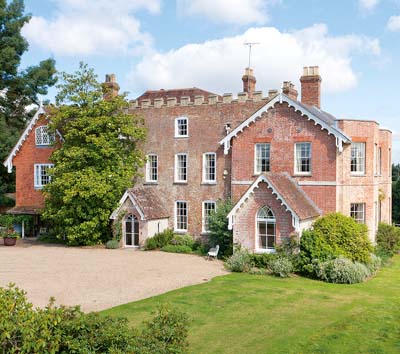Two fantastic rectories in Kent for sale
Buyers looking for something out of the ordinary could be drawn to two historic old rectories for sale in Kent


Trying to move things forward in the Kent country-house market at the moment is a bit like walking through treacle, says regional buying agent Colin Mackenzie. ‘Paradoxically, there are plenty of good clients looking to buy in Kent, but they are being much more specific about the kind of house they're looking for. For example, many want "a good solid Georgian house", something of a rarity in Kent. Others want to be within the catchment area of a good State school. And with more people looking to downsize rather than trade up, there is a desperate shortage of good village houses for sale.'
But it's a well-known fact that homebuyers who set out with a fixed idea of the kind of house they want to buy often end up-quite happily-with something completely different. Certainly, the sale of two intriguing and historic old rectories, neither of which can be said to fit neatly into any of the usual categories, will arouse the interest of buyers who are specifically looking for ‘something out of the ordinary'.
This week sees the launch in Country Life of the enchanting Rectory Park at Horsmonden, nine miles from Tunbridge Wells. Set in 116 acres of gardens, parkland, pasture and woodland, the property, listed Grade II*, can best be described as a house of many parts, ranging from a 15th- century west wing extended in the 16th century, to a grand Georgian east wing, with Victorian additions in between. Historically, the living of the 15th-century rectory and its 12th-century parish church of St Margaret's was in the patronage of the surrounding Horsmonden estate, owned first by the Archbishopric of Canterbury, and, from the 12th century, by a succession of eminent families, including that of Henry, Earl of Northumberland, who deeded it to Henry VIII in the 1530s.
According to local records, the estate was inherited in the mid 18th century by James Marriott of Spelmonden, a man of the cloth. His predecessor, William Hassell, rector from 1724 to 1785, had added the four-room Georgian wing to the rectory ‘at very considerable expense'. Marriott proceeded to gentrify the interior of the main 16th-century section, adding a number of features purloined from St Margaret's church, including a former pulpit stairway that now links the top end of the main 18th-century staircase to an upstairs bathroom, along with swathes of panelling and four columns used to support the ceiling of the main reception hall. He also added the stable block, the coach house and the wonderful walled kitchen garden, the latter very much the present owners' pride and joy.

On Marriott's death in 1825, the estate was inherited, along with a baronetcy, by the Rev William Marriott Smith-Marriott who left his mark on the landscape, by improving the gardens, damming a stream in the park to create a large lake for boating and fishing, and building a new boat house and two new lodges. He also gave the front façade a slightly bizarre Victorian flavour by adding two wings with moulded bargeboards, and a Gothic-style white-brick parapet linking the pre-existing red gables to left and right. For Pevsner, the net effect was ‘unbeautiful, almost symmetrical', but it's all part and parcel of Rectory Park's quirky charm.
The Smith-Marriott family lived on at the rectory until 1944, when the Rev Sir Hugh Cavendish Smith-Marriott died and the property was put up for sale. In 1953, it was bought by Judge Glazebrook, and was the childhood home of his son, the writer Philip Glazebrook. Judge Glazebrook carried out a substantial tree-replanting programme and further developed the gardens. Following his death, Rectory Park was put up for sale in July, 1988.
At the time, David and Patricia Davenport were living nearby and not particularly looking to move, but they decided to have a look anyway; three months later, they and their family were fully installed. Over the years, the Davenports have nurtured the gardens and woodland, established a beef herd and added farm buildings, an indoor swimming pool and a tennis court.
Exquisite houses, the beauty of Nature, and how to get the most from your life, straight to your inbox.
Although there is still work to be done, especially in the medieval west wing, which needs complete renovation, Rectory Park, with its five fine reception rooms, nine bedrooms and five bathrooms, is a magical country property that feels untouched by time, yet is less than an hour from the City of London. Strutt & Parker (01732 459900) quote a guide price of £5 million. Vanessa and Dominic Goodwin had no real idea of what they were looking for when, in 2004, they decided to move back to England from Germany with schools for their children as their first priority. Mrs Goodwin's mother was to accompany them, but there was no question of her living in a granny annexe-she wanted somewhere with enough room for her substantial library and many enormous pieces of furniture.
Having soon realised that Surrey house prices were beyond their reach, the Goodwins eventually fell in love with another ‘house of many parts', the Grade II-listed Old Rectory at Boughton Malherbe, near Tenterden, Kent, originally built as a hall house in about 1460, and used as a rectory from then until 1953, when it was sold off.
The rectory was extended from the 16th century onwards and incorporates a variety of architectural styles, from the grand, high-ceilinged medieval dining hall to the light and elegant Queen Anne library and drawing room and the beamed kitchen and snug, with its large open fireplaces and wood-burning stoves. It was the answer to the Goodwins' prayers, so, despite rumours that the house was haunted by a hunchback monk, they went ahead with the purchase, having been suitably reassured by the local vicar. Mrs Goodwin's mother was comfortably installed in her own wing with her books and furniture, and the rest of the house provided living space galore for the Goodwins and their young family. But now they need to move within the catchment area of Cranbrook School, so they have reluctantly put The Old Rectory back on the market with Savills (01580 720161) at a guide price of £2.3m.
Boughton Place cottages, St Nicholas church and The Old Rectory are all that really remain of the medieval village that grew up around the manor house owned by the powerful Wotton family, who prospered notably under Elizabeth I. The estate was later inherited by the 4th Earl of Chesterfield, who stripped Boughton Malherbe Place and removed its contents to his house in London. The Old Rectory, which has its own spring-fed water, sits in 6.6 acres of natural ponds, paddock, gardens and woodland, halfway up a hillside overlooking the Weald, within easy reach of mainline stations at Headcorn and Lenham, and grammar schools at Maidstone, Canterbury, Faversham and Ashford. In terms of accommodation, the property has four main reception rooms, two kitchens, 10 bedrooms, four bathrooms and a self-contained two-bedroom studio.
* Subscribe to Country Life and up to £50
Country Life is unlike any other magazine: the only glossy weekly on the newsstand and the only magazine that has been guest-edited by His Majesty The King not once, but twice. It is a celebration of modern rural life and all its diverse joys and pleasures — that was first published in Queen Victoria's Diamond Jubilee year. Our eclectic mixture of witty and informative content — from the most up-to-date property news and commentary and a coveted glimpse inside some of the UK's best houses and gardens, to gardening, the arts and interior design, written by experts in their field — still cannot be found in print or online, anywhere else.

